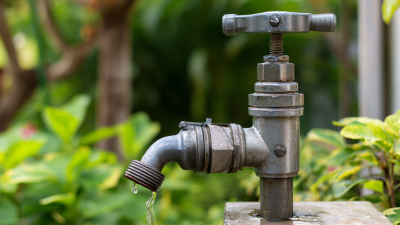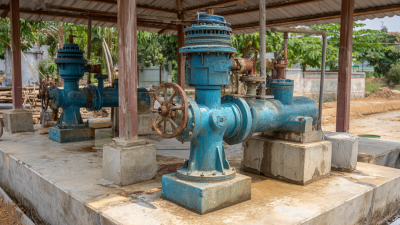Our Blog
Check out our innovative pump solutions and industry insights to see what's new in the pumping industry. Stay up to date with the latest trends and news in the world of pumping technology by following our pumping technology blog.
- Home
- Blog
2025 Top 10 Deep Well Water Pumps: Ultimate Guide for Efficient Water Supply
In the quest for an efficient water supply, understanding the intricacies of deep well water pumps becomes paramount. As we move closer to 2025, the demand for reliable water extraction solutions continues to rise, driven by agricultural needs and urban development. Industry expert Dr. Emily Carter, a leading figure in water resource management, emphasizes, "Choosing the right deep well water pump can significantly impact not only the efficiency of water extraction but also its long-term sustainability."

This guide delves into the top 10 deep well water pumps of 2025, providing insights and evaluations that will aid consumers, contractors, and agriculturalists alike in making informed decisions. Whether you are looking to upgrade your irrigation system, supply water to a new construction, or ensure a steady water supply for your household, understanding the various features and specifications of deep well water pumps is crucial.
In this comprehensive overview, we will explore the latest technologies and designs that define the market, assess user feedback, and highlight the key factors to consider when choosing a deep well water pump. Join us as we navigate through the most efficient options available, ensuring your water supply meets the demands of the future.
Factors to Consider When Choosing Deep Well Water Pumps
When selecting a deep well water pump, there are several critical factors to consider to ensure optimal efficiency and longevity. The first aspect is the pump's depth and capacity. It's essential to determine the depth of your water source and the required flow rate. This information helps you select a pump that can achieve your goals without overworking itself, which can lead to increased wear and tear.
Another important factor is the type of pump technology. Submersible pumps are widely used due to their efficiency and ability to operate underwater. However, centrifugal pumps might be more suitable for certain applications, especially where the water level fluctuates. Additionally, evaluating the materials used in the pump’s construction can affect its durability and corrosion resistance, particularly in areas with high mineral content in water. Lastly, consider the energy efficiency ratings, as this will impact both performance and long-term operational costs.
Comparison of Different Types of Deep Well Water Pumps
When selecting a deep well water pump, it’s essential to understand the various types available and their specific applications.
 Submersible pumps are one of the most common types, designed to operate underwater, efficiently delivering water from significant depths. They are generally quieter and require less maintenance than other models.
On the other hand, jet pumps are suitable for shallower wells and work by creating a vacuum to lift water to the surface. This makes them ideal for applications where the water level is high.
Submersible pumps are one of the most common types, designed to operate underwater, efficiently delivering water from significant depths. They are generally quieter and require less maintenance than other models.
On the other hand, jet pumps are suitable for shallower wells and work by creating a vacuum to lift water to the surface. This makes them ideal for applications where the water level is high.
Tips: When choosing a pump, consider the depth of your well and the intended water usage. If your well is deeper than 25 feet, a submersible pump will likely be more efficient. Additionally, ensure that the pump's horsepower matches the volume of water needed for your household or irrigation needs to prevent burnout.
Lastly, solar-powered deep well pumps are an excellent choice for those wanting an eco-friendly option. They harness solar energy to operate, making them suitable for remote locations without access to electricity. However, it's crucial to evaluate the warranty and maintenance requirements for each type to ensure longevity and reliability.
Efficiency Ratings and Performance Metrics of Deep Well Pumps
When selecting a deep well water pump, efficiency ratings and performance metrics play a crucial role in ensuring an effective water supply. Efficiency ratings measure how well a pump converts electrical energy into hydraulic energy, which directly affects its operational costs and longevity. Typically, deeper wells require pumps that maintain high efficiency under varying loads. Understanding these ratings can help buyers make informed decisions that align with their specific water needs.
Performance metrics consider factors like flow rate, head height, and durability under extreme conditions. Flow rate, usually measured in gallons per minute (GPM), indicates how much water the pump can deliver, while head height refers to the maximum vertical distance the pump can lift water. A robust pump should provide consistent flow rates even as the water level fluctuates. Furthermore, assessing a pump's durability, particularly its material quality and resistance to corrosion, is vital for long-term performance in challenging environments. By focusing on these parameters, consumers can select the most suitable deep well pump for reliable water supply.

Top 10 Recommended Deep Well Water Pumps for 2025
When selecting a deep well water pump for 2025, it’s essential to consider models that combine efficiency, reliability, and advanced technology. The market is flooded with options, but our top ten recommendations stand out due to their performance and user satisfaction. One of the key features to look for in these models is the ability to handle varying depths and flow rates, ensuring a consistent water supply regardless of the well's conditions.
Among the top picks, brands like Grundfos and Franklin Electric consistently receive high ratings. Their pumps are designed to maximize energy efficiency, reducing operational costs over time. Features such as stainless steel construction enhance durability, while programmable settings offer customizable operation, catering to different water needs.
Reviews from users highlight the ease of installation and maintenance, making them a practical choice for both residential and agricultural applications. As you explore the best deep well water pumps for 2025, consider these recommended models to secure an efficient and effective water supply for your needs.
Maintenance Tips for Extending the Lifespan of Deep Well Pumps
Maintaining deep well water pumps is crucial for ensuring a reliable water supply and extending their operational lifespan. According to a recent report from the Water Quality Association, regular maintenance can increase the lifespan of a deep well pump by 30-50%. Routine checks of the pump's mechanical components, such as bearings and seals, are essential to prevent wear and tear, which can lead to costly repairs or replacements. Additionally, monitoring the motor's performance and ensuring it operates within the manufacturer's recommended range can significantly reduce the risk of overheating and subsequent failure.
Another key maintenance tip is to inspect the pump for signs of corrosion, especially in areas where water quality may be compromised. The American Ground Water Trust suggests that using high-quality materials in pump construction can mitigate these risks. Furthermore, maintaining optimal water levels in the well helps reduce strain on the pump. Data indicates that pumps operating under the wrong conditions can experience a decrease in efficiency by up to 40% within the first year of use. By regularly maintaining their deep well pumps, homeowners and businesses can save on energy costs and ensure a consistent water supply for years to come.
2025 Top 10 Deep Well Water Pumps: Ultimate Guide for Efficient Water Supply
| Rank | Pump Type | Max Depth (ft) | Flow Rate (GPM) | Efficiency (%) | Warranty (Years) |
|---|---|---|---|---|---|
| 1 | Submersible Pump | 300 | 20 | 85 | 5 |
| 2 | Jet Pump | 150 | 18 | 80 | 3 |
| 3 | Hand Pump | 100 | 5 | n/a | Lifetime |
| 4 | Solar Pump | 200 | 15 | 90 | 2 |
| 5 | Electric Pump | 250 | 25 | 88 | 4 |
| 6 | Centrifugal Pump | 200 | 30 | 87 | 3 |
| 7 | Vortex Pump | 180 | 12 | 82 | 3 |
| 8 | Diaphragm Pump | 150 | 10 | 85 | 5 |
| 9 | Positive Displacement Pump | 120 | 8 | 80 | 2 |
| 10 | Pneumatic Pump | 90 | 7 | 78 | 3 |
Related Posts
-

Discover How Deep Well Pumps Revolutionize Sustainable Water Solutions in Modern Agriculture
-

2025 Top 10 Domestic Water Pumps: Unmatched Efficiency and Performance You Need!
-
Maximizing Efficiency: How Submersible Pumps Revolutionize Water Management in Agriculture
-

Essential Guide to Choosing the Perfect Well Water Pump for Your Home Needs
-

The Ultimate Guide to Choosing the Right Deep Well Water Pump for Your Needs
-

Exploring the Efficiency of Deep Well Pumps in Sustainable Agriculture Practices


